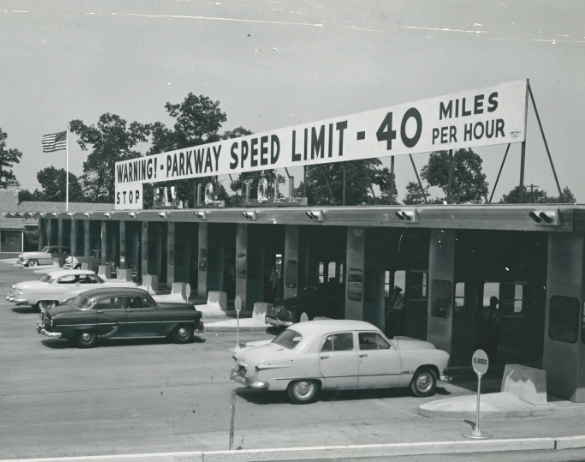Below we list some crazy facts about the Southern State Parkway. Photo: The historical photo in this article shows newly-installed toll booths on the Southern State Parkway in 1954.
- Designed by Robert Moses, the Southern State Parkway began construction in 1925
- It originally ended at Bay Shore Road when work was completed in 1949 but the roadway was extended in 1962 to its current terminus at the exits to the Sagtikos and Heckscher parkways
- The Southern State Parkway was originally maintained by the Long Island State Park Commission (LISPC)
- Robert Moses was the commissioner of the LISPC
- According to nycroads.com, “the Long Island Parkway System was envisioned as great ribbon parks, stretching east-west and north-south across Long Island, providing scenic access and linkage between the state parks then under development, such as Jones Beach, Bethpage and Sunken Meadow”
- The Long Island Parkway System followed the same design characteristics as the parks, including stone-faced arched bridges, turf shoulders, bracketed-arm wood light posts, post-and-rail fences and guide rails
- People may remember the distinct and quaint wooden lamposts along the parkway sometimes affectionately known as "woody" lights
- Moses used an undeveloped tract of land owned by the borough of Brooklyn to develop the roadway
- Brooklyn used to import its drinking water from wells on Long Island but abandoned the right-of-way to the wells after it merged with New York City in the late 1800s
- According to nycroads.com, “the right-of-way was to be used for the proposed Southern State Parkway.”
- The original Southern State Parkway was an undivided four lane roadway that was 42-feet wide
- A state police substation and barracks were built on either side of the parkway in North Valley Stream
- A medium service station was built in the 1930s east of Exit 32 (Route 110)
- The remnants of the service station that closed in 1985 can still be seen in the form of abandoned ramps in the median
- Toll Booths were originally located between exits 13 and 14
- After the NYSDOT took over maintenance of the parkway in 1978 the toll booths were removed
- According to one report, “this closure came after a 20-year battle for their removal, and three years after a toll hike from 10 cents to 25 cents that angered parkway users.”
- Signage telling motorists that Democratic Governor Hugh Carey was responsible for the removal of the toll booths, for the removal of the booths, Long Island Republicans, who lobbied for their removal, were angered
- When the parkway was first built, Governor Franklin D. Roosevelt wanted to have a western extension of the Southern State Parkway that went into Brooklyn
- This extension became the Belt Parkway
- The parkway was first built to go around Hempstead Lake - between Exits 18 and 19
- Later an earthen mound was filled in to allow the parkway to go across the lake
- Before the NYSDOT took over the parkway, new lighting and signs were installed with white lettering on brown background in the style of the LISPC
- The signs were changed in the late 1980s
- The Southern State Parkway was built in a meandering style meant for low speed traffic through parkland
- The stone overpasses were created with low clearances to prevent commercial traffic from using the parkway
- In Robert A. Caro’s biography of Robert Moses, The Power Broker, the author says that Moses ordered the bridges to be built low to prevent buses from the city away from Jones Beach
- This apocryphal story might not be 100% true, according to some
- The parkway is 25.53-miles long
- Following the suburban expansion after WWII into Long Island, Southern State Parkway was widened and straightened in places to allow for higher speeds and more traffic
- Robert Moses never learned to drive
- A porton of Sothern State Parkway between exit 17 and 32 is known as "blood alley" because of the many lethal accidents
- According to Newsday, “accident data from 2012 showed there were 1.1 fatal collisions per mile along the 25.5-mile road, built nearly a century ago — compared to only .21 per mile on the Northern State Parkway.”










